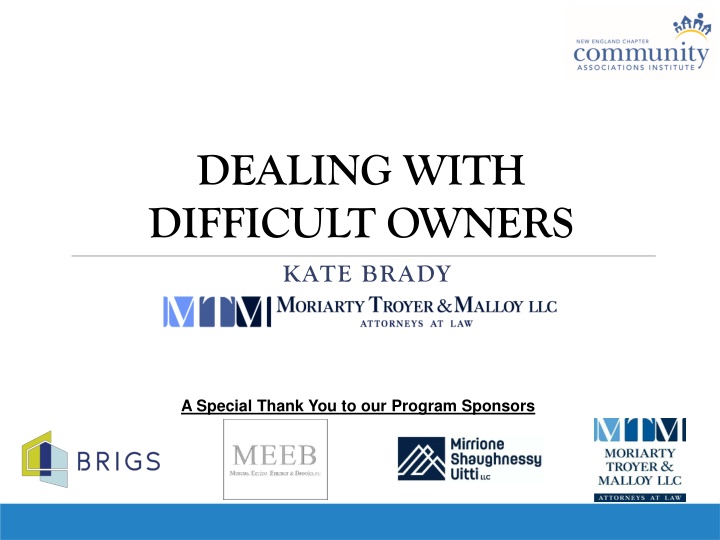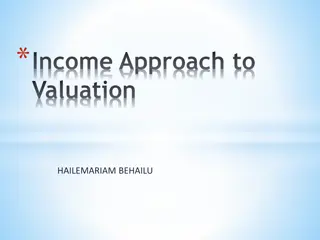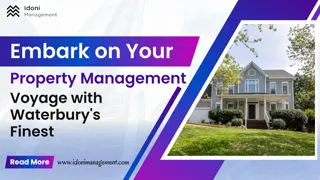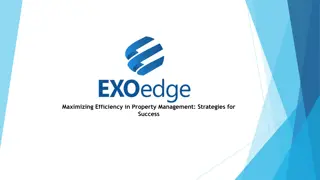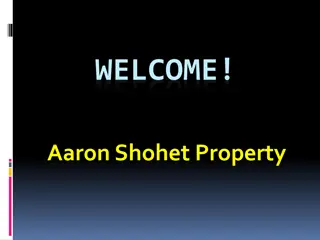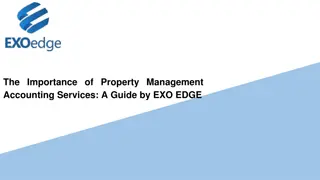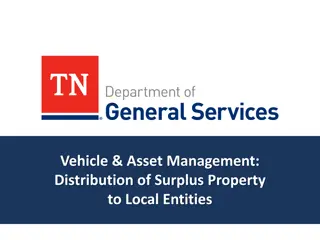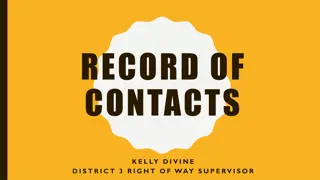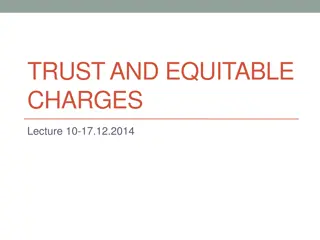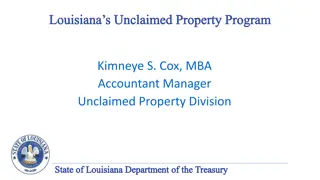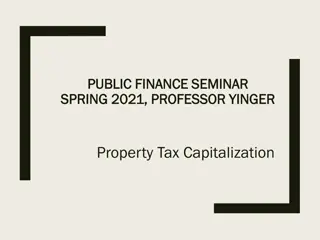Dealing with Difficult Owners in Property Management
Explore the challenges property managers face when dealing with difficult owners, including scenarios of resident conflicts and the importance of board intervention. Learn about developing a complaint policy, understanding harassment responsibility, and ways to address issues effectively to maintain a harmonious community environment.
Download Presentation

Please find below an Image/Link to download the presentation.
The content on the website is provided AS IS for your information and personal use only. It may not be sold, licensed, or shared on other websites without obtaining consent from the author.If you encounter any issues during the download, it is possible that the publisher has removed the file from their server.
You are allowed to download the files provided on this website for personal or commercial use, subject to the condition that they are used lawfully. All files are the property of their respective owners.
The content on the website is provided AS IS for your information and personal use only. It may not be sold, licensed, or shared on other websites without obtaining consent from the author.
E N D
Presentation Transcript
DEALING WITH DIFFICULT OWNERS KATE BRADY A Special Thank You to our Program Sponsors
Property Manager Roles Fiscal Services Contract & Vendor Services Building Management People Manager Clerical Support Meeting Support
Difficult Resident Scenario #1 Resident versus Resident Complaints.
Resident v. Resident Complaints Should the Board Intervene? Does the Complaint Involve Enforcement of the Rules? What is the impact on the general community/property? Does the complained of conduct amount to harassment?
Intervene? Options. Is this strictly between two owners (and does not involve harassment)? May be able to leave it to the owners. General building problem? Community- wide communication.
Intervene? Options (Contd) Does the complained of conduct violate the governing documents? Implicate the common areas or generally interfere with owners rights? Obligation to enforce the condominium governing documents and to do so fairly and consistently. This could entail investigation and the imposition of progressive penalties including: warnings/cease and desist, fines and seeking a court order.
Complaint Policy Develop a complaint policy Must be consistent with governing documents How should complaints be made (form, written) To whom should the complaints be made What will the Board do with the complaint: investigation, hearings, formal written response? When will the complaint be resolved.
Harassment: Responsibility Is there Board responsibility? Yes. It is imposed by the Department of Housing and Urban Development to housing providers. Third Party Liability Rule. The HUD rule went into effect in 2016 and applies to third parties. This means that Associations may be held liable as a third party if they can exercise control to try the stop the harassment, but fail to do so.
Harassment: Responsibility Hostile Environment Harassment is unwelcome conduct that is sufficiently severe and pervasive directed at aggrieved person who is a member of a protected class and that conduct interferes with the use or enjoyment of a dwelling or interferes with the enjoyment of services and facilities. The housing provider must take steps reasonably calculated to correct and end the harassment.
Harassment: Liability The Association may be liable if: a board member, agent, employee or owner creates a hostile environment that harasses a resident who is a member of a protected class. Association can be responsible if it knew or should have known. What is the Association to do? Take actions reasonably calculated to stop it.
Harassment Response: Options EXTERNAL RESOURCES BOARD ACTION Look to the documents for enforcement authority Physical Danger: Police Restraining Order: Victim may be able to seek a civil restraining order. Education/Training Issue warnings/violation notice Mediation: Availability of Third Party Mediation Services. Assess fines Send cease and desist Limit facility access Court action/injunction
Anti-Harassment Policy Action Items. PROHIBIT harassment and discrimination and identify who is protected and who must comply. DEFINE the statements/conduct that constitutes harassment and discrimination. IDENTIFY how residents can make a complaint for harassment. EXPLAIN the process for handling complaints, including investigation and how result will be communicated. SET out the penalties for violation of the policy.
Difficult Resident Scenario #2 Owners who cannot take care of themselves and/or are a threat to self, others or property.
Residents who cannot Care for Self or Property Examples: Resident who forgets to turn off stove after use. Resident who does not set the thermostat appropriately. Resident who does not properly dispose of bodily or pet waste. Resident who becomes a hoarder. Issue: Pose a risk to self, others and/or property.
Response Strategies Document issues. Put the concerns in writing to resident. Reach out to contact/family members. Reach out to local resource groups. Pose immediate and serious threat of harm to self or property call the police/local resource officer for a wellness check. If the issue persists and is serious, consult an attorney about court action/injunction.
Concerns with Response Sensitivity and Privacy. Only discuss with those who need to know. Do not communicate medical diagnosis/information with third parties. Stick with articulating your concerns about the conduct/behavior. Discrimination Concerns. Resident may not be able to take care of themselves due to disability. May need to provide a reasonable accommodation/modification. Also need to take steps to protect property and other residents. Delicate balance. Contact counsel with questions.
Difficult Resident Scenario #3 Owners who disrupts meeting and makes false statements about the Board/Management.
Meeting Preparation: Planning and Tools Before the Meeting a. Civility Pledge/Statements/Rules. b. Provide outlets for complaints outside the meeting process (informational meetings, complaint email/box, board meeting Q&A). c. Organize an agenda. d. Set time limits for speaking e. Be prepared to address hot button topics; have ready responses and appropriate professionals attend. f. Distribute appropriate information in advance. g. Exclude non-owners from meetings.
Meeting Conduct: Tools At the Meeting a. Review the rules and agenda at the outset. b. Stick to the agenda. c. Adhere to the time limits for speaking. d. Model civility. e. Require civility. f. Record the meeting? Your jurisdiction may require consent and there may be issues with creating this type of Association record. g. Impose penalties for offending conduct. h. Eject offending owner if they continue to disrupt meeting; avoid physical escalation. i. Keep accurate meeting minutes.
Difficult Resident Scenario #4 Owners who spreads false information about the Board/Management.
Slander/Libel? Opinion/complaining versus making a false statement of facts. The Board does not know what it is doing. Board Member X stole money from the reserves. Who heard it Were the false accusations made in the presence of others or disseminated to others? Who was it about. Has the statement caused harm.
Options for Response Move on. Positive Communication and transparency. Provide accurate information; the board/property manager can use their bully pulpit to correct the false information spread whether in real time at a meeting or through an owner communication. Develop Social Media Policy/Statement. Cease and Desist and legal response options.
QUESTIONS QUESTIONS
